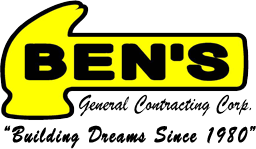How to Handle Changes in New Construction on Long Island
It’s not uncommon for homeowners to struggle with visualizing their home addition, renovation, or Long Island dormer until construction is already underway. That’s when changes to the design or scope of work may become necessary — and that’s okay. With the right Nassau County general contractor and architect, these mid-project changes can be managed smoothly and professionally.
Here’s how to keep your project on schedule, within budget, and under control — even when changes happen:
1. Preconstruction: Start With a Detailed Plan
- Have a clear, written scope before the project starts.
Make sure you receive a well-defined contract and a project schedule before any work begins. - Review everything with your contractor.
Sit down with your team and go over the house design thoroughly. Ask questions and ensure all details are understood upfront.
Ben’s General Contracting has a proven preconstruction process that helps address potential challenges before the job begins — saving time and money.
2. Make Changes Early — The Earlier, The Better
- Get involved from day one.
We encourage clients to engage early in the design and planning phase. - Schedule pre-construction walkthroughs.
At Ben’s, we conduct walkthroughs with homeowners and key team members days or even weeks before construction starts. This is the best time to raise concerns or finalize decisions.
3. Communicate at Key Milestones
Stay in close communication with your Long Island remodeling contractor during key stages:
- After Framing:
This is when you can really visualize the space. If you need to move a wall or doorway, now is the time. - Before Drywall:
Plumbing and electrical rough-ins are done. If you need to move a light or fixture, it’s still easy to do at this point. - Before the Final Punch List:
A walkthrough near the end of the project gives you the chance to address final changes before completion.
4. Understand the Impact of Late Changes
Your project follows a “critical path” — a timeline where each task depends on the one before it. For example, flooring comes after spackle, which comes after drywall, which comes after insulation.
Late-stage changes can disrupt this timeline and require multiple trades to rework.
Common mid-project changes include:
- Changing materials like flooring, tile, or countertops (often with long lead times)
- Modifying layouts (e.g., moving a wall or door)
- Adding features (e.g., built-ins, fireplaces, or altering kitchen design)
5. Managing Changes the Right Way
Once you’ve decided to make a change:
- Make sure your contractor provides a written change order promptly.
- Your team may need to return to the drawing board or submit as-built drawings to the building department.
- Be prepared to adjust the schedule and budget. Work closely with your contractor to minimize delays and stay on track.
6. Start Strong: Hire the Right Team
- Choose a contractor and architect with a structured preconstruction plan.
- At Ben’s, our Preconstruction Services Agreement (PSA) helps reduce surprises and change orders.
- You’ll receive a detailed estimate that outlines the full project scope.
- Make finish decisions early — our PSA guides you through this process before construction begins.
Let’s Build It Right — From the Start
Planning a renovation or new construction project on Long Island? Let’s talk. We’ve handled countless mid-project design changes — and we’ve got this.
Call Ben’s General Contracting Corp. today at (516) 623-2945.
https://www.projectmanagement.com/articles/279757/controlling-mid-stream-change#_
https://www.linkedin.com/advice/3/youre-faced-client-altering-project-scope-midway-msqec












